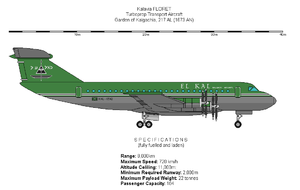Floret
 A Floret in the livery of its launch operator, El Kal. | |
| Type: | Civil turboprop transport aicraft |
| Manufacturer: | Kalavia Fixed-Wing Works, Gravelbottom |
|
| |
| Range | 8,000km |
| Maximum Speed | 720km/h |
| Altitude Ceiling | 11,000m |
| Minimum Required Runway | 2,000m |
| Maximum Payload Weight | 22 tonnes |
| Passenger Capacity | 104 |
The Floret is a civil transport aircraft produced by Kalavia, a unitary enterprise of the Kalgachi government.
Development History
Between 159 and 193 AL the Jingdaoese-made Jan-van-Gent VII had provided Kalgachia's only means of foreign cargo shipment outside the grasp of Raspur Pact interference - the aircraft were considered so important that the Kalgachi government paid far over the market rate for their purchase and willingly offered their manufacturer, Sokoku Industries, an exhorbitant maintenance contract. The payments required by the arrangement would eventually amount to the Kalgarrand equivalent of one tonne of gold bullion each year for 45 years, far exceeding the rest of Kalgachia's foreign trade turnover combined. By 204 AL, with rail links established to Batavia, the Jan-van-Gent contract became untenable in the eyes of Kalgachia's Directorate of Labour and Economic Planning and was quietly abandoned.
While the new rail links largely solved the problem of freight shipment, ideas began to circulate around the draughting rooms of Kalavia, Kalgachia's only aircraft manufacturer, for a cheaper domestically-made transport aircraft that could be used for miscellaneous duties such as the fast shipment of high-value cargoes or passengers[1]. Although authorised by Kalavia management, the resulting design project languished for a number of years behind more important priorities such as the mass production of Whirdlebirb helicopters and the technical refinement of the Oobakeep reconnaissance aircraft - a natural consequence of Kalavia's status as a wholly-owned unitary enterprise of the Kalgachi Defence Force. Only after 215 AL did the required development resources become fully available and the project commenced in earnest under the working name of Turbobirb. The original proposal for an official name, Fleurette, was considered too politically-charged for export sales and was eventually adjusted to the more neutral Floret - ostensibly due to its slimmer, more pleasing appearance than the Jan-van-Gent and its native origin in the 'Garden', as the Kalgachi called their homeland.
Coming from a manufacturer inexperienced in fixed-wing transports, the emerging aircraft inevitably came to resemble a fusion of Kalavia's previous engineering experience with that of the civil aeronautical cadre at El Kal. The undercarriage and empennage were duplicated wholesale from the Jan-van-Gent, the engines were a hybrid of the Whirdlebirb's turboshaft engine with its turbojet modification as used in the Oobakeep, and the counter-rotating propellers were run from a modification of the Whirlebirb's coaxial rotor drive. As many of the required components had been fabricated and tested in Kalavia's workshops during the Floret's long gestation - often without explicit permission - their incorporation in the prototype airframe was accomplished with unexpected ease.
The Floret's first test flight was successfully carried out in early 217 AL. The only significant problem noted was the feeble power of the elevators which, combined with a rear undercarriage somewhat aft of the aircraft's fully fuelled and loaded centre of gravity, required a significant and sustained effort by both pilots to rotate the aircraft for takeoff - the same problem created a tendency for the nose to fall heavily on landing. The aircraft's more agreeable characteristics included a good climb rate, an impressive cruise speed which approached those of turbojets and responsive ailerons and rudder which offered manoeuvrability in tight traffic patterns. Old Jan-van-Gent pilots undergoing conversion training on the first production Florets rated its handling to be considerably smoother and more agile except in turbulent air, to which its lighter airframe was more susceptible.
Operational History

El Kal took delivery of its first Florets in late 217 AL and the aircraft was offered for international sale through the Octavian Import-Export Corporation, with a dozen units sold to ESB Logistics of Constancia. The aircraft's performance in Constancian service led in turn to its conversion by Ergostásio Aeroskafón as an Airborne Early Warning platform for the Raspur Pact, entering service with the Black Legions of the Unified Governorates in 228 AL.
See also
References
- ^ The objective was especially pushed by embedded initiates of the Troglodyti as part of a wider inter-generational project known as The Speciation, begun in the Minarborian era with the objective of amending or displacing, with an expanding corpus of uniquiely Micrasian alternatives, such customs and creations as had emerged throughout history by liminal aetheric communication with, and consequent imitation of, the co-resonant dimensional realm of Terra - a habit practiced by many nations and considered idly uninspired to the point of civilisational degeneracy.